
Donut Dish
The Donut Dish, meticulously engineered by A.S Engineers & Fabricators, stands as a groundbreaking innovation in the realm of vessel design and engineering. With a rich legacy spanning more than three decades since our establishment in 1986, we are honored to unveil a product that not only sets new standards but also reshapes the landscape of industrial applications. The Donut Dish epitomizes our commitment to excellence, offering a paradigm shift in how space is utilized without compromising on performance. Its ingenious design and advanced features make it the go-to solution for industries seeking unparalleled efficiency and functionality in their vessel systems.Strategies
Material Selection: Choosing the right material
is crucial for the performance of the dish end. Materials like carbon steel, stainless
steel, and aluminum are commonly used based on factors such as corrosion resistance,
strength, and cost.
Thickness Calculation: Engineers calculate the required thickness of the dish end to
withstand the operating pressure and any other loads it may be subjected to. This
calculation involves considering factors such as the material properties, design codes
(e.g., ASME Boiler and Pressure Vessel Code), and safety margins.
Head Type Selection: Selecting the appropriate type of dish end (ellipsoidal, torispherical,
hemispherical, or conical) depends on various factors including pressure rating, space
constraints, and process requirements. Each type offers different advantages in terms of
pressure resistance, volume capacity, and ease of fabrication.


.png)